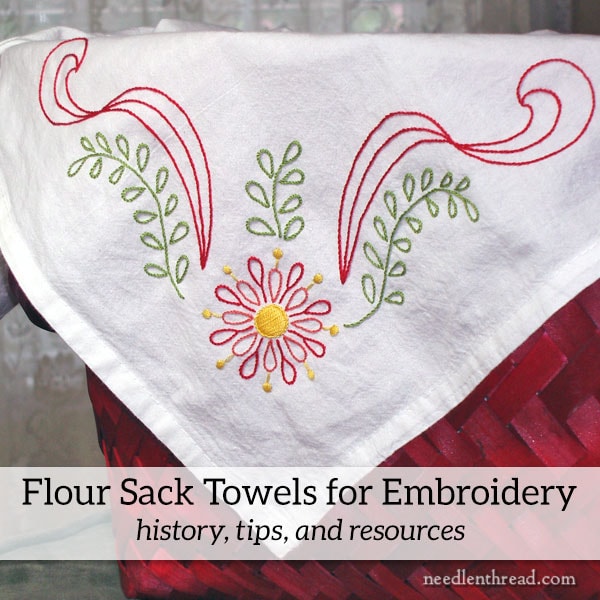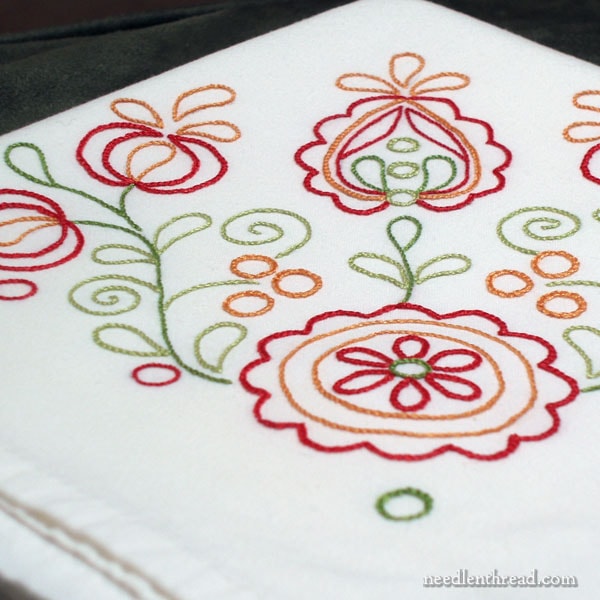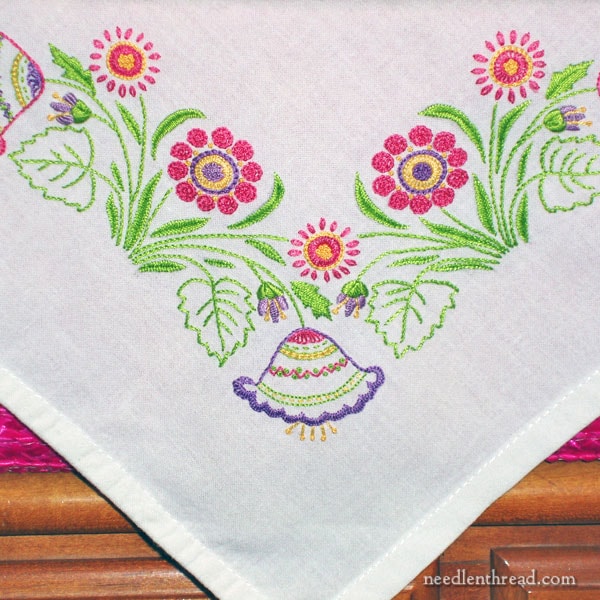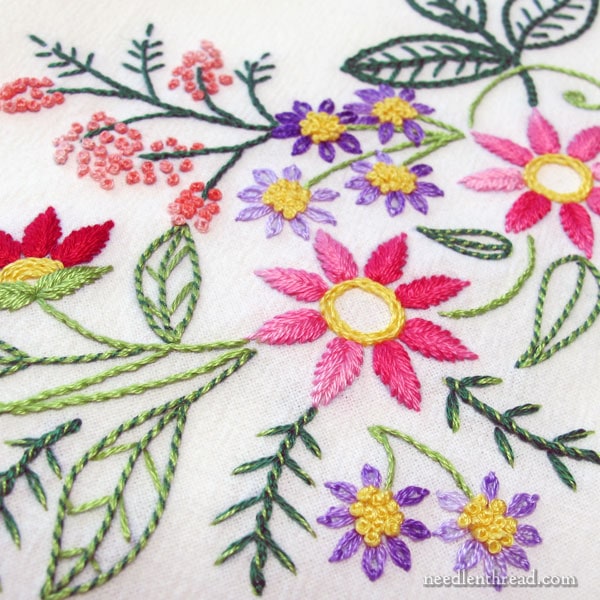Embroidered flour sack towels have been a Thing in America since the first half of the 20th century.
Today, we’ll talk a little bit about their history, why they work great for embroidery, and why they’re still a favored item in the home and in the commercial kitchen.
I’ll also share some resources for flour sack towels that I think work well for hand embroidery. I’m always on the look-out for the best flour sack towels, so I’ve run into both the good and the bad over the years.

So, before the ubiquitous flour sack towel of the early 1900’s, there was the tea towel or the glass towel – linen towels that were lintless, absorbent, quick drying, and perfect for drying and polishing dishes until they sparkled.
Linen towels are certainly beautiful, and, when free of any sizing, they are absorbent, lint free, and great for drying.
But, the fact is, cotton towels are more affordable and they do a darned good job of drying things.
Flour Sack History
Cotton flour sacks came into commercial use shortly after the Industrial Revolution. They replaced the barrel for flour storage and shipping. By the time the late 1800’s and the early 1900’s rolled around, flour sacks were salvaged by thrifty housewives to use as toweling, thanks to their absorbency and lint-free nature.
At the dawn of the 1930’s, as America plunged into the Great Depression, the flour sack became much more than just a sack or a towel. As a source of cheap cloth, the flour sack eventually moved, as General Mills puts it, “from the kitchen to the closet,” with companies purposely bagging their flour and other goods in colorful cloth bags that could be recycled into clothes.
Clever marketers, the companies even printed logos and consumer information onto the sacks with washable ink, so that, when re-purposing, the brand information could be washed away, leaving a decent piece of cloth ready for use. This is a good reminder that packaging is often a huge selling point!

It was in the mid 1930’s through the 60’s that the flour sack towel as a base for embroidery really took off. Companies like Vogart, Aunt Martha, Workbasket, McCall’s, Simplicity, and others produced iron-on transfers of often simple, cartoonish line drawings that could be easily transferred to toweling and then stitched relatively quickly. Embroidered “tea towels” and other linens were all the rage, and among these household goods, the humble flour sack towel got a face-lift, too.
Still Popular Today
Even though the days of packaging flour in cotton sacking have long passed, the flour sack towel has never really gone out of style. This isn’t necessarily because it makes a good ground for embroidery and other craft uses, though.
Primarily, this is because the relatively thin, large, lint-free, firmly woven cotton towel is an asset in any kitchen. Its highly absorbent properties rival the paper towel, and it lasts a whole heck of a lot longer, making it an economic choice for kitchen and household use. Nothing dries a glass or a newly washed countertop with quite the same efficiency as a flour sack towel!
With the resurgence of interest in vintage iron-on transfers these days, the flour sack towel has come into its own again in the craft world, too.

There are many grades of flour sack towels available today. In the US, almost every kitchen-related section in any store carries the things. None of them are quite the same as the original flour sacks sold through the first half of the 1900’s, though. I have an old flour sack towel from the early 1940’s, made from a re-purposed sack. It’s not at all the same as the webby, often loose-weave stuff that’s sold today. It’s closely and firmly woven, soft (though with starch, it could be stiffened up quite easily), smooth cotton, neatly hand-hemmed all around.
Traits to Look For in a Flour Sack Towel
Flour sack towels are not expensive, but some are definitely better than others. When looking for a good flour sack towel to use as a base for embroidery, these are the things you want:
1. A close weave. If the threads are far apart – more like cheesecloth than toweling – it’s not going to be a good ground for embroidery.
2. A smooth hand. Most flour sack towels today have what I’d call small rolling hills in them. There’s a bit of waviness to the surface. While this can’t often be avoided, look for towels that are less hilly than others. The hillier they are, the more chance of distortion and puckering when embroidering them.
3. Lint free. No, really. I mean lint free!! So many towels are purported to be lint free, but often they’re not. Cheaper towels are made from shorter staple, cheap cotton – the remnants of the cotton industry – and they give off a lot of lint. If you’re not sure how lint free your towels are, throw them in the laundry! One run through the washer and the dryer will tell a good story. On the bright side, this may eliminate a good bit of lint and make them much more usable as lint-free(ish) towels. It may also shrink the towel and close up the weave a bit.
4. Fully hemmed all around – and preferably, with a twice-turned hem. This means that the raw edge is inside the hem and not visible on the back of the towel.
Prepping a Flour Sack Towel for Embroidery
Here are a couple steps that will help you achieve the best results with your hand embroidery on flour sack towels:
1. Always run them through the laundry before you stitch them. Wash and dry them how you plan to wash and dry them when they’ve been used. Even if you’re giving them as gifts, wash them first! You want to remove all the sizing, and you want them to shrink if they need to. I always pre-wash flour sack towels before I embroider them, using the hot water cycle and drying them in a dryer.
2. Iron them before transferring your design, and use either spray starch to get a really nicely ironed surface, or use a spray bottle of water. You want the corner or edge you plan to embroider to be as smooth and wrinkle free as possible when you do your transfer, whether you’re using an iron-on transfer or tracing the design on with a pencil.

Embroidery Tips
When stitching on flour sack towels, you want the back to be decently tidy. It doesn’t have to be as tidy as the front, but it should look somewhat tidy, since it will be exposed.
This article will give you a few tips to keep in mind, to help you keep the back neat when stitching on a flour sack towel.
Some More Reading
Here are a couple articles about the history of flour sacks that make interesting reading:
How Flour Sacks went from Kitchen to Closet – from General Mills
The History of Flour Sack Towels – from Mary’s Kitchen
What is a Tea Towel – from Mary’s Kitchen
Resources for Flour Sack Towels
I’ve not had good luck with flour sack towels bought in most department and discount stores. I’ve tried them from Walmart, Target, and pretty much all the big box craft stores. These are some of the problems I’ve found with commonly available flour sack towels:
1. Too loosely woven, so that they don’t support embroidery well.
2. Uneven and sometimes cut slightly on the bias, which makes them stretchy and causes the embroidery to distort.
3. Bad hem jobs, so that they look cheap – not the best for gift-giving.
4. Lint-full rather than lint-free.
Of all the flour sack towels online that I’ve tried so far, I like two well enough – the deluxe flour sack towels from ACS Home and Work and the 28×28 premium flour sack towels from Colonial Patterns.
The ACS Home & Work towels (the company used to be American Chair Store) are slightly different now from what they were when I’d ordered them some nine or ten years ago. They aren’t quite as smooth. Also, be aware that they are not white-white. They’re more cream or off-white.
The Colonial Pattern towels are white-white. They’re maybe a tad bit spongier than the ACS towels, but they’re still quite decent for embroidery, and I like the fact that they’re white-white.
I generally purchase square flour sack towels when I can, because they can be used for so much more than a kitchen towel. They can be used as a bread basket liner (to cover hot rolls or bread in a basket and keep them warm). They can be used as a quick centerpiece on a small table, like a tea cloth. They can be used to line a gift basket for bridal showers.
Right now, I have an order in to two different companies that I’ve heard make nice towels. One is Mary’s Kitchen, which I linked to in the articles above. When they arrive, I’ll try them out and let you know how they are. The other is a wholesale company that only sells in very large quantities, but their towels are made in the US and they look like they’re nicely finished, so I’ll try those out, too.
I’ll keep you posted on further explorations!






